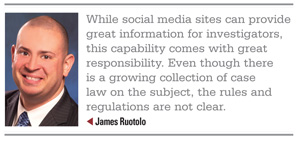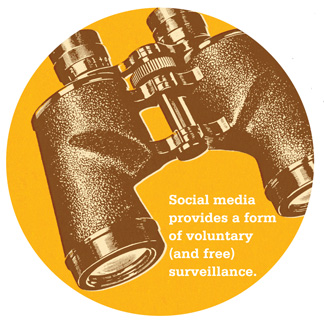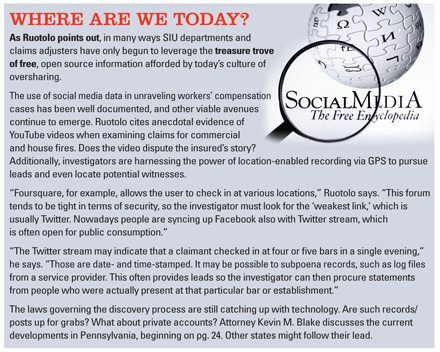Social media has quickly become the foremost activity on the Internet. The explosive growth in user-generated content has been a boon for insurance claims adjusters and fraud investigators. Navigating the social media landscape, however, can be tricky.
When the World Wide Web was established, early websites were mostly electronic versions of documents. They did a good job at broadcasting information to a wide audience but were not effective at brokering communication. With the advent of Web 2.0 and social media platforms such as Facebook, YouTube, and Twitter, bidirectional communication became one of the key reasons to use the Web.
The adoption rate for the use of social media in our daily lives is astounding. When radio was introduced, it took 38 years to reach 50 million people. Television was faster, reaching 50 million in only 13 years. The iPod reached this milestone in three years. Facebook did it in mere months. Social media technology is changing the way the world communicates. Half of all mobile Internet traffic in the U.K. is for Facebook. It should be pointed out that it's not just kids using social media sites. The Pew Internet & American Life Project reports that 46 percent of all American adults use at least one social networking site.
There are literally hundreds of social media sites on the Web today offering platforms for sharing all kinds of information, including photos, videos, status updates, and location check-ins. This has resulted in an explosion of user-generated content. Today, we create as much information in two days as we did from the beginning of time through 2003.
 Given the swell in user-generated content housed on social media sites, it is no surprise that investigators turn to them when conducting background investigations.
Given the swell in user-generated content housed on social media sites, it is no surprise that investigators turn to them when conducting background investigations.
Doing the Digging
With all of this potentially useful information hiding in social media sites, many investigators are adding online social media research to their investigative strategies. The SIU director of a major insurer says, "depending on the type of case, it could be a routine investigative action."
Social media provides a form of voluntary (and free) surveillance. As users create new content, the data they produce and the metadata stored by the platforms they use can be a tremendous resource for claims investigators. Information can be found on claimants, witnesses, vendors, medical providers, and even loss events themselves. The Coalition Against Insurance Fraud (CAIF) reports several cases where social media sites helped SIU investigators, including a case where "an injured worker who claimed he was too hurt to get out of bed, yet he had time to update his Myspace page and post upcoming dates and venues his rock band was playing."
The use of social media information during fraud investigations is not limited to injury claims but can also be used across all lines of business. Let's look at a few examples:
- Auto. While reviewing a suspicious accident involving two drivers that allegedly do not know each other, investigators discover they are in fact "friends" on Facebook. This suggests that the accident may have been staged.
- Property. Upon receipt of a homeowner's fire loss, investigators discover amateur video footage of the fire in progress on YouTube. This footage clearly contradicts statements made by the insured.
- Workers' compensation. An injured worker's LinkedIn profile lists a new employer during the time she is continuing to collect benefits for temporary total disability.
- Liability. A claim against an insured restaurant is filed when a customer complains that he discovered glass in his food. A review on Yelp written by another customer describes the event and mentions that the claimant "was obnoxious from the moment he sat down" and appeared to be "totally faking it."
 Following the Rules
Following the Rules
While social media sites can provide great information for investigators, this capability comes with great responsibility. Even though there is a growing collection of case law on the subject, the rules and regulations are not clear. Investigators must be careful when conducting social media research since its mostly uncharted legal waters.
In November 2008, Lori Drew was convicted of computer fraud when she created a fictitious Myspace profile in order to taunt one of her daughter's classmates, who committed suicide after being subjected to Drew's cyberbullying. Though the conviction was ultimately overturned, the case serves as a warning to investigators. Regarding the Drew case, investigative researcher Tamara Thompson writes in her blog, "Let this be a warning to information researchers and investigators who are collecting data on subjects through their social networking sites … keep in mind: Is this legal and ethical?" For this reason, it is important for a company to establish strict rules about the proper use of social media sites for investigative purposes. One SIU director indicated, "The potential for someone to be overzealous in their attempts to investigate a case using social networking sites is significant … so getting permission to access them comes with a pretty high responsibility." While it is acceptable to passively gather publicly available information from these sites, investigators must comply with the user agreements for each social media service and avoid the use of pretext.
Accessing Protected Information
Most social media platforms offer some form of privacy protection to users. In many cases, the user can choose from a variety of options for sharing or protecting content. In some instances, the settings are universal—all content is protected. Other times, users may be able to choose a privacy setting for an individual post, photo, or other content. One thing is clear, however. Information posted on these sites is intended to be shared with someone. This is important because courts have held that this reduces the expectation of privacy and has made it somewhat easier for insurers and attorneys to access private or protected information on social media sites.
While investigators are free to view publicly accessible information, the greatest level of detail is obtained when a user account can be accessed directly. Doing so requires some additional steps. If a claim is in litigation, for instance, then defense counsel may issue a subpoena to the social media site or attempt to secure the data via interrogatory.
More courts are allowing access to such information, especially if the publicly accessible content suggests the information may be favorable to the other party or insurer. For example, in Romano v. Steelcase Inc., a 2010 New York Supreme Court case, Romano sued Steelcase because of "permanent injuries" that prevented her from leading an active lifestyle. Steelcase argued the public portions of Romano's Myspace and Facebook pages showed she was living a more active lifestyle and that Romano should be required to turn over all social media content, even the information that she had only intended to share with her friends.
The court ruled that precluding Steelcase from accessing Romano's profiles "would condone [her] attempt to hide relevant information behind self-regulated privacy settings." It was reasonable to conclude that the profiles "may contain further evidence such as information with regard to her activities and enjoyment of life, all of which are material and relevant to the defense of this action."
The New Frontier
While many SIUs have added social media research to their investigative toolbox, it is often overwhelming to deal with the massive amount of social media content. Many insurers are struggling to adequately train analysts and investigators in the latest search techniques, trying to find the balance between using a tremendous (free) information source with conducting efficient research. Today's research is largely a manual exercise, scouring the social media landscape looking for useful information about a claimant and a given loss event. It will not be that way for long.
Advanced analytics will change the way social media is used in investigations. Powerful technologies like text mining, sentiment analysis, content categorization and social network analysis can automate social media research and be integrated into the fraud identification and predictive modeling process. In the future, fraud detection engines will be based not just on claims and policy data, but also on Facebook friends and Twitter posts.
A New Resource
While there are cases where individuals essentially confess to committing insurance fraud on their social media profiles—usually in the form of bragging to impress their friends—it is rare to find a smoking gun. Instead, social media serves as a useful, open-source intelligence research tool to identify leads. It is critical to combine social media research with traditional investigative sources for a more complete picture. Certainly people can post misinformation or exaggerations, as well. Therefore it is important to validate and corroborate the information discovered online with other sources whenever possible.
Social media sites can be a tremendous resource, but investigators must proceed with caution. Social media sleuthing should always be an integrated part of a larger investigation using a variety of tools to make a prudent claim decision. It definitely provides an advantage to the investigator resulting in valuable leads for further probing.

Want to continue reading?
Become a Free PropertyCasualty360 Digital Reader
Your access to unlimited PropertyCasualty360 content isn’t changing.
Once you are an ALM digital member, you’ll receive:
- Breaking insurance news and analysis, on-site and via our newsletters and custom alerts
- Weekly Insurance Speak podcast featuring exclusive interviews with industry leaders
- Educational webcasts, white papers, and ebooks from industry thought leaders
- Critical converage of the employee benefits and financial advisory markets on our other ALM sites, BenefitsPRO and ThinkAdvisor
Already have an account? Sign In Now
© 2025 ALM Global, LLC, All Rights Reserved. Request academic re-use from www.copyright.com. All other uses, submit a request to [email protected]. For more information visit Asset & Logo Licensing.








